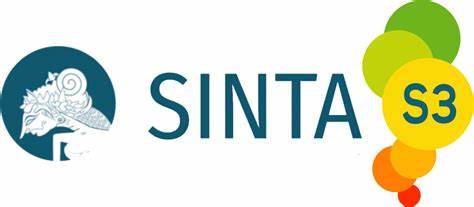DIFFERENTIATED LEARNING IN TEACHING SPEAKING: CHALLENGES AND SOLUTIONS
Keywords:
Pembelajaran Berdiferensiasi, Tantangan mengajar, Keterampilan BerbicaraAbstract
This research explores the challenges faced by English teacher in implementing differentiated learning methods, particularly in speaking skills and investigates the solutions toward the problems. The study uses a qualitative method with case study design. As it was employed to describe the experiences of an English teacher at a high school in Surabaya who applied the differentiation learning method. The respondent of this research is an English teacher who is employing differentiated learning. This research used interviews and observations to collect the data. The results showed that the teacher faced several challenges in using differentiated learning in teaching speaking. The challenges are selecting content that suits students' level ability, managing passive students, and dealing with students with confidence, anxiety, and vocabulary and grammar issues as a product of learning. The learning environment also presents challenges, such as noise and classroom facilities. In addition, the data also revealed that teacher found solutions toward the problems, such as providing multiple texts, allowing active students to speak in turns, offering design products based on negotiation, and calming the class to maintain concentration. These solutions have made students comfortable in learning, as they are tailored to their skills, character, learning styles, and needs.
References
Ary, D., Jacob, L. C., Sorensen, C., & Razavieh, A. (2009). Introduction to Research in
Education.
Asriyani, R., Suryawati, D. A., & Anggayan, I. W. A. (2019). Using Role Play Techniques
in Improving English Speaking Competency on the Personality Types. Proceedings
International Conferences on Cultural Studies, 2, 44–48.
Cole, D., Ellis, C., Mason, B., Meed, J., Record, D., Rossetti, A., & Willcocks, G. (2007).
Teaching speaking and listening a toolkit for practitioners About the Key Skills Support Programme. 12.
Harris, D. P. (1969). Testing English as a second language.
Ertmer, P. A., & Newby, T. J. (1993). Behaviorism, Cognitivism, Constructivism: Comparing Critical Features from an Instructional Design Perspective. Performance
Improvement Quarterly, 6(4), 50–72. https://doi.org/10.1111/j.1937-8327.1993.tb00605.x
Gardner, H., & Hatch, T. (1989). Educational implications of the theory of multiple intelligences. Educational researcher, 18(8), 4-10.
Ismail, S. A. A., & Al Allaq, K. (2019). The Nature of Cooperative Learning and Differentiated Instruction Practices in English Classes. SAGE Open, 9(2). https://doi.org/10.1177/2158244019856450
Kristiani, H., Susanti, E. I., Purnamasari, N., Purba, M., Saad, M. Y., & Anggaeni. (2021).
Model Pengembangan Pembelajaran Berdiferensiasi.
Luoma, S. (2010). Introduction. Assessing Speaking. Cambridge University Press.
Magableh, I., & Abdullah, A. (2020). The Effect of Differentiated Instruction on EFL Learners: Teachers’ Perspective. International Journal of Academic Research in Business and Social Sciences, 10(5), 1-16. https://doi.org/10.6007/ijarbss/v10-i5/7235
Oktavia, H. E. (2024). The Implementation Of Merdeka Belajar Curriculum in Teaching Speaking to The Ninth Grade of Smp Al Irsyad Al Islamiyyah Purwokerto (Doctoral dissertation, State Islamic University).
Moleong, L. J. 1993. Metodologi Penelitian Kualitatif. Bandung: PT Remaja Rosdakarya.
Noviska, D. W., & Anastasia, F. (2023). Students’ Learning Styles (VRAK Model) in Learning English. Didaktika : Jurnal Kependidikan, 17(1), 58–70. https://doi.org/10.30863/didaktika.v17i1.4132
Pakula, H. M. (2019). Teaching speaking. Apples-Journal of Applied Language Studies, 13(1), 95-111.
Jaya, H. P., Petrus, I., & Pitaloka, N. L. (2022). Speaking performance and problems faced
by English major students at a university in South Sumatera. Indonesian EFL Journal, 8(1), 105-112.
Reis, S. M., & Renzulli, J. S. (2018). The five dimensions of differentiation. International Journal for Talent Development and Creativity, 6, 87-94.
Richards, J. C., & Bohlke, D. (2011). Creating effective language lessons. Cambridge, UK: Cambridge University Press.
Smets, W., De Neve, D., & Struyven, K. (2022a). Responding to students’ learning needs:
how secondary education teachers learn to implement differentiated instruction. Educational Action Research, 30(2), 243–260. https://doi.org/10.1080/09650792.2020.1848604
Smets, W., De Neve, D., & Struyven, K. (2022b). Responding to students’ learning needs:
how secondary education teachers learn to implement differentiated instruction. Educational Action Research, 30(2), 243–260. https://doi.org/10.1080/09650792.2020.1848604
Sulistianingrum, E., Fauziati, E., Rohmah, W., & Muhibbin, A. (2023). Differentiated Learning : The Implementation of Student Sensory Learning Styles in Creating Differentiated Content. Jurnal Paedagogy, 10(2), 308. https://doi.org/10.33394/jp.v10i2.7030
Suryati, I., Ratih, K., & Maryadi, M. (2023). Teachers' Challenges in Implementing Differentiated Instruction in Teaching English at Junior High School. Eduvest-Journal of Universal Studies,3(9), 1693-1708.
Tomlinson, C. A., & Moon, T. R. (2013a). Differentiation: An Overview. Assessment and Student Succes in a Differentiated Classroom, 1–16.
Tomlinson, C. A., & Moon, T. R. (2013b). Differentiation: An Overview. Assessment and Student Succes in a Differentiated Classroom, 1–16.
Wijayanti, I. D. (2023, October). Analysis of Implementation of Independent Curriculum: Diagnostic Assessment and Differentiated Learning in Elementary Schools. In Syekh
Nurjati International Conference on Elementary Education (Vol. 1, pp. 134-143).
Downloads
Published
Issue
Section
License

This work is licensed under a Creative Commons Attribution-ShareAlike 4.0 International License.
The author is responsible for acquiring the permission(s) to reproduce any copyrighted figures, tables, data, or text that are being used in the submitted paper. Authors should note that text quotations of more than 250 words from a published or copyrighted work will require grant of permission from the original publisher to reprint. The written permission letter(s) must be submitted together with the manuscript.




